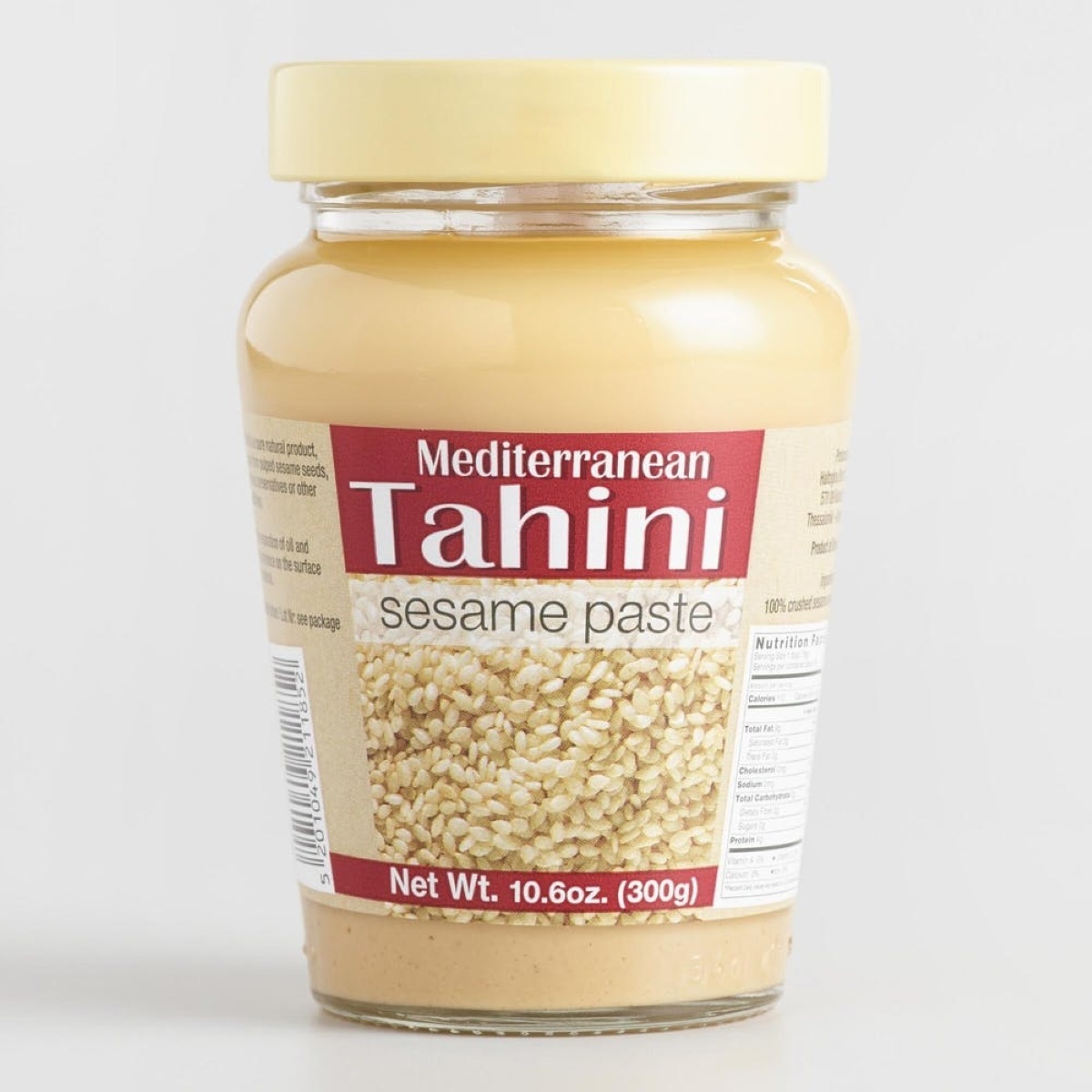

Articles
How To Store Tahini
Modified: January 8, 2024
Learn the best techniques for storing tahini with our informative articles. Keep your tahini fresh and delicious for longer periods.
(Many of the links in this article redirect to a specific reviewed product. Your purchase of these products through affiliate links helps to generate commission for Storables.com, at no extra cost. Learn more)
Introduction
Welcome to our guide on how to store tahini! If you’re a fan of this delicious Middle Eastern condiment, you know how versatile it can be. Made from ground sesame seeds, tahini has a rich and nutty flavor that adds depth to a variety of dishes. Whether you use it as a dip, a sauce, or an ingredient in your favorite recipes, proper storage is key to maintaining its freshness and flavor.
In this article, we will explore what tahini is, discuss why proper storage is important, and provide you with the best ways to store both unopened and opened tahini. We’ll also share some tips for extending its shelf life, so you can enjoy this delectable condiment for longer. So, let’s dive in and discover the secrets to properly storing tahini!
Key Takeaways:
- Proper storage of tahini is crucial to maintain its rich flavor, creamy texture, and nutritional value. Follow these guidelines to preserve the freshness and quality of both unopened and opened tahini, ensuring delightful culinary experiences.
- Extend the shelf life of your tahini by practicing good hygiene, avoiding cross-contamination, and regularly inspecting for spoilage. With proper storage and additional tips, you can savor the delectable flavors of tahini for an extended period.
Read more: How To Store Opened Tahini
What is Tahini?
Before we delve into the nitty-gritty of storing tahini, let’s take a moment to understand what this delectable condiment is. Tahini is a paste made from ground sesame seeds, originally hailing from the Middle East. It has been a staple in Mediterranean and Middle Eastern cuisines for centuries.
The process of making tahini involves grinding hulled sesame seeds until they release their natural oils, resulting in a smooth and creamy texture. While it may seem simple, the flavor and texture of tahini can vary depending on the quality of the sesame seeds used and the manufacturing process.
Tahini boasts a unique and distinctive taste with a rich, nutty aroma. It adds depth and creaminess to a variety of dishes, making it a versatile ingredient in both savory and sweet recipes. From traditional Middle Eastern dishes like hummus and baba ganoush to salad dressings, marinades, and even desserts, tahini is a star player in the culinary world.
One of the reasons why tahini has gained popularity in recent years is its nutritional profile. It is an excellent source of healthy fats, including monounsaturated fats, which are heart-healthy. Tahini is also rich in vitamins and minerals, such as calcium, iron, and magnesium. Additionally, it contains protein and dietary fiber, making it a nutritious addition to a balanced diet.
Now that we understand the basics of tahini, let’s move on to why it’s important to store it properly to maintain its freshness and flavor.
Why is Proper Storage Important?
Proper storage of tahini is essential to preserve its freshness, flavor, and nutritional qualities. The quality of tahini can deteriorate if it is not stored correctly, resulting in a less enjoyable culinary experience. Here are a few reasons why proper storage is important:
1. Flavor Preservation
Tahini has a rich and distinct flavor that can be easily affected by external factors such as air, light, heat, and moisture. Exposure to these elements can cause the sesame oil in tahini to become rancid, resulting in an unpleasant taste. By storing tahini properly, you can maintain its original flavor and ensure that it enhances your dishes as intended.
2. Texture Maintenance
Proper storage also helps preserve the creamy and smooth texture of tahini. When exposed to air, tahini can thicken or develop a gritty texture over time. By storing it correctly, you can ensure that the tahini maintains its velvety consistency, making it easier to incorporate into your recipes.
Read more: How To Store Tahini After Opening
3. Shelf Life Extension
Tahini, like any other food product, has a limited shelf life. Proper storage can help extend the lifespan of tahini, allowing you to enjoy it for a longer period. This is particularly important if you use tahini infrequently or purchase it in bulk, as it helps prevent waste and saves you money in the long run.
4. Nutritional Value Retention
Tahini is packed with essential nutrients, including healthy fats, vitamins, and minerals. However, improper storage can lead to a loss of these nutrients over time. By storing tahini correctly, you can help preserve its nutritional value, ensuring that you reap the maximum benefits from this wholesome ingredient.
Now that we understand the importance of proper storage, let’s explore the best ways to store both unopened and opened tahini.
Best Ways to Store Tahini
Whether you have an unopened jar of tahini or you’ve already cracked it open, following these storage methods will help keep your tahini fresh and flavorful:
1. Store in a Cool, Dark Place
Tahini is sensitive to light and heat, which can promote rancidity and flavor deterioration. It’s best to store unopened tahini in a cool, dark pantry or cupboard away from direct sunlight and sources of heat, such as the stove or oven. The ideal temperature for storing tahini is between 50-70°F (10-21°C).
Read more: How To Store Basil From Store
2. Seal Tightly
Both unopened and opened tahini should be stored in airtight containers or jars to prevent air and moisture from getting in. Make sure the lid is tightly sealed, as exposure to air can cause the tahini to oxidize and spoil faster.
3. Refrigerate After Opening
Once you’ve opened your jar of tahini, it’s recommended to store it in the refrigerator. Cooler temperatures slow down the oxidation process and help preserve the flavor and texture for a longer period. Transfer the tahini to a clean, airtight container before refrigerating.
4. Keep Away from Strong Odors
Tahini can absorb strong odors from other foods in the fridge or pantry. To prevent it from picking up unwanted flavors, store tahini away from foods with strong aromas, such as onions, garlic, and spices.
5. Avoid Freezing
While some condiments freeze well, tahini is not one of them. Freezing can cause the oil to separate and alter the texture of the tahini. It’s best to avoid freezing tahini unless you plan to use it as an ingredient in a frozen dessert.
By following these storage methods, you can maximize the shelf life and preserve the quality of your tahini, ensuring that it remains delicious and ready to enhance your favorite recipes.
Read more: How To Store Store-Bought Bread
Storing Unopened Tahini
If you have a jar of unopened tahini, you can follow these guidelines to store it properly:
1. Check the Expiry Date
Before storing unopened tahini, make sure to check the expiry date on the packaging. Most commercially packaged tahini has a shelf life of around one to two years. It’s best to purchase tahini that has a later expiry date to ensure it lasts longer.
2. Keep it in the Original Packaging
Unopened tahini is usually packaged in a jar or bottle that is specifically designed to keep it fresh. The packaging provides a barrier against light and air, helping to maintain its quality. It’s recommended to store unopened tahini in its original packaging until you’re ready to use it.
3. Store in a Cool, Dry Place
Find a cool, dry place such as a pantry or cupboard to store your unopened tahini. Make sure the storage area is away from direct sunlight and sources of heat. Fluctuations in temperature can negatively impact the quality of the tahini.
Read more: How To Store Basil From Grocery Store
4. Avoid Temperature Extremes
Extreme temperatures, either hot or cold, can affect the consistency and taste of tahini. Avoid storing unopened tahini near the stove, oven, or any other heat sources. Additionally, do not store it in the refrigerator, as the cold temperature can cause the tahini to harden and become difficult to use.
5. Don’t Mix with Water or Other Ingredients
It’s important to keep unopened tahini pure and free from any contaminants. Avoid adding water or any other ingredients to the jar before opening it. This will prevent spoilage and maintain the original texture and flavor of the tahini.
By following these guidelines, you can ensure that your unopened tahini stays fresh and ready to enjoy when you’re ready to use it.
Storing Opened Tahini
If you’ve opened a jar of tahini and have some leftover, it’s important to store it properly to maintain its freshness and quality. Follow these steps to store opened tahini:
1. Transfer to an Airtight Container
Once you’ve opened the original packaging of tahini, it’s best to transfer the remaining tahini to an airtight container. This will help prevent air from reaching the tahini and potentially causing oxidation and flavor deterioration.
Read more: How To Store DVDs
2. Clean the Jar Rim
Before transferring the tahini, make sure to clean the rim of the original jar. Any residue on the rim can lead to a less effective seal, allowing air and moisture to enter the container. Wipe the rim clean with a damp cloth before sealing the new container.
3. Store in the Refrigerator
Refrigeration is the best option for storing opened tahini. Place the airtight container in the refrigerator, preferably on one of the upper shelves. The cooler temperature will slow down the oxidation process and help preserve the freshness and flavor of the tahini for a longer period.
4. Use Within a Reasonable Timeframe
While refrigeration helps extend the shelf life of opened tahini, it’s important to note that it still has a limited lifespan. Tahini can typically be stored in the refrigerator for up to 3-4 months after opening. However, it’s best to use your own judgment and check for any signs of spoilage, such as unusual smells or changes in texture.
5. Stir Before Use
When you’re ready to use the refrigerated tahini, give it a good stir. The sesame oil in tahini can separate and rise to the top during storage. Mixing it back together will ensure a consistent texture and flavor when incorporating it into your recipes.
By following these steps, you can prolong the freshness and quality of your opened tahini, allowing you to continue enjoying its deliciousness in a range of dishes.
Read more: How To Store Keepsakes
Tips for Extending Shelf Life
In addition to proper storage techniques, there are a few extra tips you can follow to further extend the shelf life of your tahini:
1. Practice Good Hygiene
When using tahini, make sure to use clean utensils or spoons to scoop out the desired amount. Avoid double-dipping or using dirty utensils, as this can introduce contaminants and accelerate spoilage.
2. Keep Moisture Out
Moisture can lead to the development of mold and bacteria in tahini. To prevent moisture from entering the jar, ensure that the rim is always clean and dry before sealing it. Additionally, avoid storing tahini near sources of steam in your kitchen, such as the stove or dishwasher.
3. Avoid Cross-Contamination
If you use tahini as a spread or dip, it’s important to use a clean spoon or knife for each serving. This helps prevent the introduction of bacteria from other food items, which can affect the quality and safety of the tahini.
Read more: How To Store Onions
4. Don’t Share Containers
If you portion out tahini into smaller containers for convenience, avoid sharing these containers with others. Each person’s utensils or fingers can introduce bacteria into the container, leading to spoilage.
5. Check for Off Odors or Changes in Texture
Regularly inspect your stored tahini for any unusual odors or changes in texture. If you notice any foul smells, a moldy appearance, or a gritty texture, it’s best to discard the tahini to ensure your safety.
By following these additional tips, you can prolong the shelf life of your tahini and continue to enjoy its delectable flavors for an extended period.
Conclusion
Tahini, with its rich flavor and creamy texture, is a versatile and beloved condiment in many cuisines. To ensure that you always have fresh and delicious tahini on hand, proper storage is key. By following the guidelines outlined in this guide, you can extend the shelf life of your tahini and maintain its original taste and quality.
Whether you have an unopened jar of tahini or you’ve already cracked it open, the storage principles remain the same. Keeping tahini in a cool, dark place away from heat, light, and moisture helps preserve its freshness. Transferring opened tahini to an airtight container and storing it in the refrigerator further extends its shelf life.
In addition to these storage techniques, it is important to practice good hygiene, avoid cross-contamination, and regularly inspect your tahini for any signs of spoilage. By following these simple tips, you can continue to enjoy the delightful flavors of tahini in a variety of dishes.
Remember to always check the expiry date on the packaging, and use your own judgment when assessing the quality of tahini. When in doubt, it’s better to err on the side of caution and discard any tahini that shows signs of spoilage.
So, whether you’re using tahini as a dip, a sauce, or an ingredient in your favorite recipes, keeping it stored properly will ensure that it remains fresh, flavorful, and ready to enhance your culinary creations. Enjoy the deliciousness of tahini for as long as possible with the proper storage methods outlined in this guide!
Frequently Asked Questions about How To Store Tahini
Was this page helpful?
At Storables.com, we guarantee accurate and reliable information. Our content, validated by Expert Board Contributors, is crafted following stringent Editorial Policies. We're committed to providing you with well-researched, expert-backed insights for all your informational needs.









0 thoughts on “How To Store Tahini”